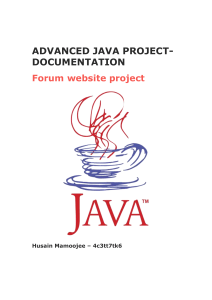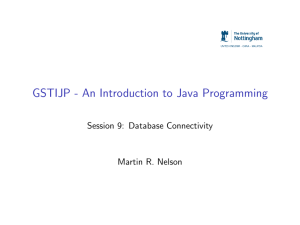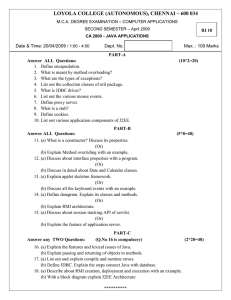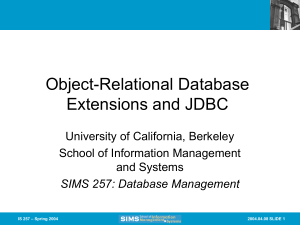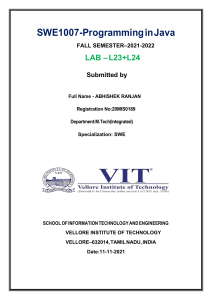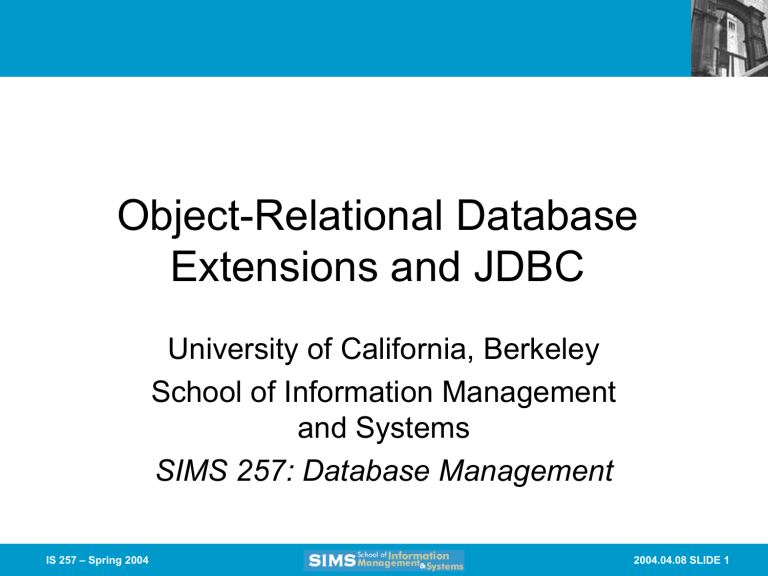
Object-Relational Database
Extensions and JDBC
University of California, Berkeley
School of Information Management
and Systems
SIMS 257: Database Management
IS 257 – Spring 2004
2004.04.08 SLIDE 1
Lecture Outline
• Object-Relational DBMS
– OR features in Oracle
– OR features in PostgreSQL
• Extending OR databases (examples from
PostgreSQL)
• Java and JDBC
IS 257 – Spring 2004
2004.04.08 SLIDE 2
Lecture Outline
• Object-Relational DBMS
– OR features in Oracle
– OR features in PostgreSQL
• Extending OR databases (examples from
PostgreSQL)
• Java and JDBC
IS 257 – Spring 2004
2004.04.08 SLIDE 3
Object Relational Databases
• Background
• Object Definitions
– inheritance
• User-defined datatypes
• User-defined functions
IS 257 – Spring 2004
2004.04.08 SLIDE 4
Object Relational Databases
• Began with UniSQL/X unified objectoriented and relational system
• Some systems (like OpenODB from HP)
were Object systems built on top of
Relational databases.
• Miro/Montage/Illustra built on Postgres.
• Informix Buys Illustra. (DataBlades)
• Oracle Hires away Informix Programmers.
(Cartridges)
IS 257 – Spring 2004
2004.04.08 SLIDE 5
Object Relational Data Model
• Class, instance, attribute, method, and
integrity constraints
• OID per instance
• Encapsulation
• Multiple inheritance hierarchy of classes
• Class references via OID object
references
• Set-Valued attributes
• Abstract Data Types
IS 257 – Spring 2004
2004.04.08 SLIDE 6
Object Relational Extended SQL (Illustra)
• CREATE TABLE tablename {OF TYPE
Typename}|{OF NEW TYPE typename}
(attr1 type1, attr2 type2,…,attrn typen)
{UNDER parent_table_name};
• CREATE TYPE typename (attribute_name
type_desc, attribute2 type2, …, attrn
typen);
• CREATE FUNCTION functionname
(type_name, type_name) RETURNS
type_name AS sql_statement
IS 257 – Spring 2004
2004.04.08 SLIDE 7
Object-Relational SQL in ORACLE
• CREATE (OR REPLACE) TYPE typename
AS OBJECT (attr_name, attr_type, …);
• CREATE TABLE OF typename;
IS 257 – Spring 2004
2004.04.08 SLIDE 8
Example
• CREATE TYPE ANIMAL_TY AS OBJECT
(Breed VARCHAR2(25), Name
VARCHAR2(25), Birthdate DATE);
• Creates a new type
• CREATE TABLE Animal of Animal_ty;
• Creates “Object Table”
IS 257 – Spring 2004
2004.04.08 SLIDE 9
Constructor Functions
• INSERT INTO Animal values
(ANIMAL_TY(‘Mule’, ‘Frances’,
TO_DATE(‘01-APR-1997’, ‘DD-MMYYYY’)));
• Insert a new ANIMAL_TY object into the
table
IS 257 – Spring 2004
2004.04.08 SLIDE 10
Selecting from an Object Table
• Just use the columns in the object…
• SELECT Name from Animal;
IS 257 – Spring 2004
2004.04.08 SLIDE 11
More Complex Objects
• CREATE TYPE Address_TY as object
(Street VARCHAR2(50), City
VARCHAR2(25), State CHAR(2), zip
NUMBER);
• CREATE TYPE Person_TY as object
(Name VARCHAR2(25), Address
ADDRESS_TY);
• CREATE TABLE CUSTOMER
(Customer_ID NUMBER, Person
PERSON_TY);
IS 257 – Spring 2004
2004.04.08 SLIDE 12
What Does the Table Look like?
• DESCRIBE CUSTOMER;
• NAME
TYPE
• ----------------------------------------------------• CUSTOMER_ID
NUMBER
• PERSON
NAMED TYPE
IS 257 – Spring 2004
2004.04.08 SLIDE 13
Inserting
• INSERT INTO CUSTOMER VALUES (1,
PERSON_TY(‘John Smith’,
ADDRESS_TY(‘57 Mt Pleasant St.’, ‘Finn’,
‘NH’, 111111)));
IS 257 – Spring 2004
2004.04.08 SLIDE 14
Selecting from Abstract Datatypes
• SELECT Customer_ID from CUSTOMER;
• SELECT * from CUSTOMER;
CUSTOMER_ID PERSON(NAME, ADDRESS(STREET, CITY, STATE ZIP))
--------------------------------------------------------------------------------------------------1
PERSON_TY(‘JOHN SMITH’, ADDRESS_TY(‘57...
IS 257 – Spring 2004
2004.04.08 SLIDE 15
Selecting from Abstract Datatypes
• SELECT Customer_id, person.name from
Customer;
• SELECT Customer_id,
person.address.street from Customer;
IS 257 – Spring 2004
2004.04.08 SLIDE 16
Updating
• UPDATE Customer SET
person.address.city = ‘HART’ where
person.address.city = ‘Briant’;
IS 257 – Spring 2004
2004.04.08 SLIDE 17
Functions
• CREATE [OR REPLACE] FUNCTION
funcname (argname [IN | OUT | IN OUT]
datatype …) RETURN datatype (IS | AS)
{block | external body}
IS 257 – Spring 2004
2004.04.08 SLIDE 18
Example
Create Function BALANCE_CHECK
(Person_name IN Varchar2) RETURN NUMBER
is BALANCE NUMBER(10,2) BEGIN
SELECT sum(decode(Action, ‘BOUGHT’,
Amount, 0)) - sum(decode(Action, ‘SOLD’,
amount, 0)) INTO BALANCE FROM LEDGER
where Person = PERSON_NAME;
RETURN BALANCE;
END;
IS 257 – Spring 2004
2004.04.08 SLIDE 19
Example
• Select NAME, BALANCE_CHECK(NAME)
from Worker;
IS 257 – Spring 2004
2004.04.08 SLIDE 20
TRIGGERS
• Create TRIGGER UPDATE_LODGING
INSTEAD OF UPDATE on
WORKER_LODGING for each row BEGIN
if :old.name <> :new.name then update
worker set name = :new.name where
name = :old.name;
end if;
if :old.lodging <> … etc...
IS 257 – Spring 2004
2004.04.08 SLIDE 21
Lecture Outline
• Object-Relational DBMS
– OR features in Oracle
– OR features in PostgreSQL
• Extending OR databases (examples from
PostgreSQL)
• Java and JDBC
IS 257 – Spring 2004
2004.04.08 SLIDE 22
PostgreSQL
• Derived from POSTGRES
– Developed at Berkeley by Mike Stonebraker
and his students (EECS) starting in 1986
• Postgres95
– Andrew Yu and Jolly Chen adapted
POSTGRES to SQL and greatly improved the
code base
• PostgreSQL
– Name changed in 1996, and since that time
the system has been expanded to support
most SQL92 and many SQL99 features
IS 257 – Spring 2004
2004.04.08 SLIDE 23
PostgreSQL Classes
• The fundamental notion in Postgres is that of a
class, which is a named collection of object
instances. Each instance has the same
collection of named attributes, and each attribute
is of a specific type. Furthermore, each instance
has a permanent object identifier (OID) that is
unique throughout the installation. Because SQL
syntax refers to tables, we will use the terms
table and class interchangeably. Likewise, an
SQL row is an instance and SQL columns are
attributes.
IS 257 – Spring 2004
2004.04.08 SLIDE 24
Creating a Class
• You can create a new class by specifying the
class name, along with all attribute names and
their types:
CREATE TABLE weather (
city
varchar(80),
temp_lo
int,
-- low temperature
temp_hi
int,
-- high temperature
prcp
real,
-- precipitation
date
date
);
IS 257 – Spring 2004
2004.04.08 SLIDE 25
PostgreSQL
• Postgres can be customized with an arbitrary
number of user-defined data types.
Consequently, type names are not syntactical
keywords, except where required to support
special cases in the SQL92 standard.
• So far, the Postgres CREATE command looks
exactly like the command used to create a table
in a traditional relational system. However, we
will presently see that classes have properties
that are extensions of the relational model.
IS 257 – Spring 2004
2004.04.08 SLIDE 26
PostgreSQL
• All of the usual SQL commands for
creation, searching and modifying classes
(tables) are available. With some
additions…
• Inheritance
• Non-Atomic Values
• User defined functions and operators
IS 257 – Spring 2004
2004.04.08 SLIDE 27
Inheritance
CREATE TABLE cities (
name
text,
population
float,
altitude
int -- (in ft)
);
CREATE TABLE capitals (
state
char(2)
) INHERITS (cities);
IS 257 – Spring 2004
2004.04.08 SLIDE 28
Inheritance
• In Postgres, a class can inherit from zero
or more other classes.
• A query can reference either
– all instances of a class
– or all instances of a class plus all of its
descendants
IS 257 – Spring 2004
2004.04.08 SLIDE 29
Inheritance
• For example, the following query finds all the
cities that are situated at an attitude of 500ft or
higher:
SELECT name, altitude
FROM cities
WHERE altitude > 500;
+----------+----------+
|name
| altitude |
+----------+----------+
|Las Vegas | 2174 |
+----------+----------+
|Mariposa | 1953 |
+----------+----------+
IS 257 – Spring 2004
2004.04.08 SLIDE 30
Inheritance
• On the other hand, to find the names of all cities,
including state capitals, that are located at an
altitude over 500ft, the query is:
SELECT c.name, c.altitude
FROM cities* c
WHERE c.altitude > 500;
which returns:
+----------+----------+
|name
| altitude |
+----------+----------+
|Las Vegas | 2174 |
+----------+----------+
|Mariposa | 1953 |
+----------+----------+
|Madison | 845
|
+----------+----------+
IS 257 – Spring 2004
2004.04.08 SLIDE 31
Inheritance
• The "*" after cities in the preceding query
indicates that the query should be run over
cities and all classes below cities in the
inheritance hierarchy
• Many of the PostgreSQL commands
(SELECT, UPDATE and DELETE, etc.)
support this inheritance notation using "*"
IS 257 – Spring 2004
2004.04.08 SLIDE 32
Non-Atomic Values
• One of the tenets of the relational model is
that the attributes of a relation are atomic
– I.e. only a single value for a given row and
column
• Postgres does not have this restriction:
attributes can themselves contain subvalues that can be accessed from the
query language
– Examples include arrays and other complex
data types.
IS 257 – Spring 2004
2004.04.08 SLIDE 33
Non-Atomic Values - Arrays
• Postgres allows attributes of an instance to be
defined as fixed-length or variable-length multidimensional arrays. Arrays of any base type or
user-defined type can be created. To illustrate
their use, we first create a class with arrays of
base types.
CREATE TABLE SAL_EMP (
name
text,
pay_by_quarter int4[],
schedule
text[][]
);
IS 257 – Spring 2004
2004.04.08 SLIDE 34
Non-Atomic Values - Arrays
• The preceding SQL command will create a class
named SAL_EMP with a text string (name), a
one-dimensional array of int4 (pay_by_quarter),
which represents the employee's salary by
quarter and a two-dimensional array of text
(schedule), which represents the employee's
weekly schedule
• Now we do some INSERTSs; note that when
appending to an array, we enclose the values
within braces and separate them by commas.
IS 257 – Spring 2004
2004.04.08 SLIDE 35
Inserting into Arrays
INSERT INTO SAL_EMP
VALUES ('Bill',
'{10000, 10000, 10000, 10000}',
'{{"meeting", "lunch"}, {}}');
INSERT INTO SAL_EMP
VALUES ('Carol',
'{20000, 25000, 25000, 25000}',
'{{"talk", "consult"}, {"meeting"}}');
IS 257 – Spring 2004
2004.04.08 SLIDE 36
Querying Arrays
• This query retrieves the names of the employees
whose pay changed in the second quarter:
SELECT name
FROM SAL_EMP
WHERE SAL_EMP.pay_by_quarter[1] <>
SAL_EMP.pay_by_quarter[2];
+------+
|name |
+------+
|Carol |
+------+
IS 257 – Spring 2004
2004.04.08 SLIDE 37
Querying Arrays
• This query retrieves the third quarter pay of all
employees:
SELECT SAL_EMP.pay_by_quarter[3] FROM
SAL_EMP;
+---------------+
|pay_by_quarter |
+---------------+
|10000
|
+---------------+
|25000
|
+---------------+
IS 257 – Spring 2004
2004.04.08 SLIDE 38
Querying Arrays
• We can also access arbitrary slices of an array,
or subarrays. This query retrieves the first item
on Bill's schedule for the first two days of the
week.
SELECT SAL_EMP.schedule[1:2][1:1]
FROM SAL_EMP
WHERE SAL_EMP.name = 'Bill';
+-------------------+
|schedule
|
+-------------------+
|{{"meeting"},{""}} |
+-------------------+
IS 257 – Spring 2004
2004.04.08 SLIDE 39
Lecture Outline
• Object-Relational DBMS
– OR features in Oracle
– OR features in PostgreSQL
• Extending OR databases (examples from
PostgreSQL)
• Java and JDBC
IS 257 – Spring 2004
2004.04.08 SLIDE 40
PostgreSQL Extensibility
• Postgres is extensible because its operation is catalogdriven
– RDBMS store information about databases, tables, columns,
etc., in what are commonly known as system catalogs. (Some
systems call this the data dictionary).
• One key difference between Postgres and standard
RDBMS is that Postgres stores much more information
in its catalogs
– not only information about tables and columns, but also
information about its types, functions, access methods, etc.
• These classes can be modified by the user, and since
Postgres bases its internal operation on these classes,
this means that Postgres can be extended by users
– By comparison, conventional database systems can only be
extended by changing hardcoded procedures within the DBMS
or by loading modules specially-written by the DBMS vendor.
IS 257 – Spring 2004
2004.04.08 SLIDE 41
Postgres System Catalogs
IS 257 – Spring 2004
2004.04.08 SLIDE 42
User Defined Functions
• CREATE FUNCTION allows a Postgres user to
register a function with a database.
Subsequently, this user is considered the owner
of the function
CREATE FUNCTION name ( [ ftype [, ...] ] )
RETURNS rtype
AS {SQLdefinition}
LANGUAGE 'langname'
[ WITH ( attribute [, ...] ) ]
CREATE FUNCTION name ( [ ftype [, ...] ] )
RETURNS rtype
AS obj_file , link_symbol
LANGUAGE 'C'
[ WITH ( attribute [, ...] ) ]
IS 257 – Spring 2004
2004.04.08 SLIDE 43
Simple SQL Function
• CREATE FUNCTION one() RETURNS int4
AS 'SELECT 1 AS RESULT'
LANGUAGE 'sql';
SELECT one() AS answer;
answer
-------1
IS 257 – Spring 2004
2004.04.08 SLIDE 44
A more complex function
• To illustrate a simple SQL function, consider the
following, which might be used to debit a bank
account:
create function TP1 (int4, float8) returns int4
as ‘update BANK set balance = BANK.balance - $2
where BANK.acctountno = $1;
select balance from bank
where accountno = $1; ‘ language 'sql';
• A user could execute this function to debit
account 17 by $100.00 as follows:
select (x = TP1( 17,100.0));
IS 257 – Spring 2004
2004.04.08 SLIDE 45
SQL Functions on Composite Types
• When creating functions with composite types, you have to include
the attributes of that argument. If EMP is a table containing
employee data, (therefore also the name of the composite type for
each row of the table) a function to double salary might be…
CREATE FUNCTION double_salary(EMP) RETURNS integer
AS ' SELECT $1.salary * 2 AS salary; ' LANGUAGE SQL;
SELECT name, double_salary(EMP) AS dream FROM EMP WHERE
EMP.cubicle ~= point '(2,1)';
name | dream
------+------Sam | 2400
Notice the use of the syntax $1.salary to select one field of the argument row value. Also
notice how the calling SELECT command uses a table name to denote the entire
current row of that table as a composite value.
IS 257 – Spring 2004
2004.04.08 SLIDE 46
SQL Functions on Composite Types
• It is also possible to build a function that
returns a composite type. This is an
example of a function that returns a single
EMP row:
CREATE FUNCTION new_emp() RETURNS
EMP
AS ' SELECT text ''None'' AS name,
1000 AS salary,
25 AS age,
point ''(2,2)'' AS cubicle; ' LANGUAGE SQL;
IS 257 – Spring 2004
2004.04.08 SLIDE 47
External Functions
• This example creates a C function by calling a
routine from a user-created shared library. This
particular routine calculates a check digit and
returns TRUE if the check digit in the function
parameters is correct. It is intended for use in a
CHECK contraint.
CREATE FUNCTION ean_checkdigit(bpchar, bpchar) RETURNS
bool
AS '/usr1/proj/bray/sql/funcs.so' LANGUAGE 'c';
CREATE TABLE product (
id
char(8) PRIMARY KEY,
eanprefix char(8) CHECK (eanprefix ~ '[0-9]{2} [0-9]{5}')
REFERENCES brandname(ean_prefix),
eancode char(6) CHECK (eancode ~ '[0-9]{6}'),
CONSTRAINT ean CHECK (ean_checkdigit(eanprefix,
eancode)));
IS 257 – Spring 2004
2004.04.08 SLIDE 48
Creating new Types
• CREATE TYPE allows the user to register a new
user data type with Postgres for use in the
current data base. The user who defines a type
becomes its owner. typename is the name of the
new type and must be unique within the types
defined for this database.
CREATE TYPE typename ( INPUT = input_function, OUTPUT =
output_function
, INTERNALLENGTH = { internallength | VARIABLE } [ ,
EXTERNALLENGTH = { externallength | VARIABLE } ]
[ , DEFAULT = "default" ]
[ , ELEMENT = element ] [ , DELIMITER = delimiter ]
[ , SEND = send_function ] [ , RECEIVE = receive_function ]
[ , PASSEDBYVALUE ] )
IS 257 – Spring 2004
2004.04.08 SLIDE 49
New Type Definition
• This command creates the box data type and
then uses the type in a class definition:
CREATE TYPE box (INTERNALLENGTH = 8,
INPUT = my_procedure_1, OUTPUT =
my_procedure_2);
CREATE TABLE myboxes (id INT4, description
box);
IS 257 – Spring 2004
2004.04.08 SLIDE 50
New Type Definition
• In the external language (usually C)
functions are written for
• Type input
– From a text representation to the internal
representation
• Type output
– From the internal represenation to a text
representation
• Can also define function and operators to
manipulate the new type
IS 257 – Spring 2004
2004.04.08 SLIDE 51
New Type Definition Example
• A C data structure is defined for the new
type:
typedef struct Complex {
double
x;
double
y;
} Complex;
IS 257 – Spring 2004
2004.04.08 SLIDE 52
New Type Definition Example
Complex *
complex_in(char *str)
{
double x, y;
Complex *result;
if (sscanf(str, " ( %lf , %lf )", &x, &y) != 2) {
elog(WARN, "complex_in: error in parsing”);
return NULL;
}
result = (Complex *)palloc(sizeof(Complex));
result->x = x;
result->y = y;
return (result);
}
IS 257 – Spring 2004
2004.04.08 SLIDE 53
New Type Definition Example
char *
complex_out(Complex *complex)
{
char *result;
if (complex == NULL)
return(NULL);
result = (char *) palloc(60);
sprintf(result, "(%g,%g)", complex->x,
complex->y);
return(result);
}
IS 257 – Spring 2004
2004.04.08 SLIDE 54
New Type Definition Example
• Now tell the system about the new type…
CREATE FUNCTION complex_in(opaque)
RETURNS complex
AS 'PGROOT/tutorial/obj/complex.so'
LANGUAGE 'c';
CREATE FUNCTION complex_out(opaque)
RETURNS opaque
AS 'PGROOT/tutorial/obj/complex.so'
LANGUAGE 'c';
CREATE TYPE complex (
internallength = 16,
input = complex_in,
output = complex_out);
IS 257 – Spring 2004
2004.04.08 SLIDE 55
Operator extensions
CREATE FUNCTION complex_add(complex,
complex)
RETURNS complex
AS '$PWD/obj/complex.so'
LANGUAGE 'c';
CREATE OPERATOR + (
leftarg = complex,
rightarg = complex,
procedure = complex_add,
commutator = + );
IS 257 – Spring 2004
2004.04.08 SLIDE 56
Now we can do…
• SELECT (a + b) AS c FROM test_complex;
• +----------------+
• |c
|
• +----------------+
• |(5.2,6.05)
|
• +----------------+
• |(133.42,144.95) |
• +----------------+
•
IS 257 – Spring 2004
2004.04.08 SLIDE 57
Creating new Aggregates
CREATE AGGREGATE complex_sum (
sfunc1 = complex_add,
basetype = complex,
stype1 = complex,
initcond1 = '(0,0)');
SELECT complex_sum(a) FROM test_complex;
+------------+
|complex_sum |
+------------+
|(34,53.9) |
+------------+
IS 257 – Spring 2004
2004.04.08 SLIDE 58
Rules System
• CREATE RULE name AS ON event
TO object [ WHERE condition ]
DO [ INSTEAD ] [ action | NOTHING ]
• Rules can be triggered by any event
(select, update, delete, etc.)
IS 257 – Spring 2004
2004.04.08 SLIDE 59
Views as Rules
• Views in Postgres are implemented using the
rule system. In fact there is absolutely no
difference between a
CREATE VIEW myview AS SELECT * FROM
mytab;
• compared against the two commands
CREATE TABLE myview (same attribute list as
for mytab);
CREATE RULE "_RETmyview" AS ON SELECT
TO myview DO INSTEAD
SELECT * FROM mytab;
IS 257 – Spring 2004
2004.04.08 SLIDE 60
Extensions to Indexing
• Access Method extensions in Postgres
• GiST: A Generalized Search Trees
– Joe Hellerstein, UC Berkeley
IS 257 – Spring 2004
2004.04.08 SLIDE 61
Indexing in OO/OR Systems
• Quick access to user-defined objects
• Support queries natural to the objects
• Two previous approaches
– Specialized Indices (“ABCDEFG-trees”)
• redundant code: most trees are very similar
• concurrency control, etc. tricky!
– Extensible B-trees & R-trees
(Postgres/Illustra)
• B-tree or R-tree lookups only!
• E.g. ‘WHERE movie.video < ‘Terminator 2’
IS 257 – Spring 2004
2004.04.08 SLIDE 62
GiST Approach
• A generalized search tree. Must be:
• Extensible in terms of queries
• General (B+-tree, R-tree, etc.)
• Easy to extend
• Efficient (match specialized trees)
• Highly concurrent, recoverable, etc.
IS 257 – Spring 2004
2004.04.08 SLIDE 63
GiST Applications
• New indexes needed for new apps...
– find all supersets of S
– find all molecules that bind to M
– your favorite query here (multimedia?)
• ...and for new queries over old domains:
– find all points in region from 12 to 2 o’clock
– find all text elements estimated relevant to a query
string
IS 257 – Spring 2004
2004.04.08 SLIDE 64
Lecture Outline
• Object-Relational DBMS
– OR features in Oracle
– OR features in PostgreSQL
• Extending OR databases (examples from
PostgreSQL)
• Java and JDBC
IS 257 – Spring 2004
2004.04.08 SLIDE 65
Java and JDBC
• Java is probably the high-level language
used in most software development today
one of the earliest “enterprise” additions to
Java was JDBC
• JDBC is an API that provides a mid-level
access to DBMS from Java applications
• Intended to be an open cross-platform
standard for database access in Java
• Similar in intent to Microsoft’s ODBC
IS 257 – Spring 2004
2004.04.08 SLIDE 66
JDBC
• Provides a standard set of interfaces for
any DBMS with a JDBC driver – using
SQL to specify the databases operations.
Resultset
Resultset
Resultset
Statement
PreparedStatement
CallableStatement
Application
Connection
DriverManager
Oracle Driver
ODBC Driver
Postgres Driver
Oracle DB
ODBC DB
Postgres DB
IS 257 – Spring 2004
2004.04.08 SLIDE 67
JDBC Simple Java Implementation
import java.sql.*;
import oracle.jdbc.*;
public class JDBCSample {
public static void main(java.lang.String[] args) {
try {
// this is where the driver is loaded
//Class.forName("jdbc.oracle.thin");
DriverManager.registerDriver(new OracleDriver());
}
catch (SQLException e) {
System.out.println("Unable to load driver Class");
return;
}
IS 257 – Spring 2004
2004.04.08 SLIDE 68
JDBC Simple Java Impl.
try {
//All DB access is within the try/catch block...
// make a connection to ORACLE on Dream
Connection con = DriverManager.getConnection(
"jdbc:oracle:thin:@dream.sims.berkeley.edu:1521:dev",
“mylogin", “myoraclePW");
// Do an SQL statement...
Statement stmt = con.createStatement();
ResultSet rs = stmt.executeQuery("SELECT NAME FROM DIVECUST");
IS 257 – Spring 2004
2004.04.08 SLIDE 69
JDBC Simple Java Impl.
// show the Results...
while(rs.next()) {
System.out.println(rs.getString("NAME"));
}
// Release the database resources...
rs.close();
stmt.close();
con.close();
}
catch (SQLException se) {
// inform user of errors...
System.out.println("SQL Exception: " + se.getMessage());
se.printStackTrace(System.out);
}
}
}
IS 257 – Spring 2004
2004.04.08 SLIDE 70
JDBC
• Once a connection has been made you
can create three different types of
statement objects
• Statement
– The basic SQL statement as in the example
• PreparedStatement
– A pre-compiled SQL statement
• CallableStatement
– Permits access to stored procedures in the
Database
IS 257 – Spring 2004
2004.04.08 SLIDE 71
JDBC Resultset methods
• Next() to loop through rows in the resultset
• To access the attributes of each row you
need to know its type, or you can use the
generic “getObject()” which wraps the
attribute as an object
IS 257 – Spring 2004
2004.04.08 SLIDE 72
JDBC “GetXXX()” methods
SQL data type
CHAR
VARCHAR
LONGVARCHAR
NUMERIC
DECIMAL
BIT
TINYINT
IS 257 – Spring 2004
Java Type
String
String
String
Java.math.
BigDecimal
Java.math.
BigDecimal
GetXXX()
getString()
getString()
getString()
GetBigDecimal()
Boolean
Byte
getBoolean()
getByte()
GetBigDecimal()
2004.04.08 SLIDE 73
JDBC GetXXX() Methods
SQL data type
SMALLINT
INTEGER
BIGINT
REAL
FLOAT
DOUBLE
BINARY
VARBINARY
LONGVARBINARY
IS 257 – Spring 2004
Java Type
GetXXX()
Integer (short) getShort()
Integer
getInt()
Long
getLong()
Float
getFloat()
Double
getDouble()
Double
getDouble()
Byte[]
getBytes()
Byte[]
getBytes()
Byte[]
getBytes()
2004.04.08 SLIDE 74
JDBC GetXXX() Methods
SQL data
type
DATE
TIME
TIMESTAMP
IS 257 – Spring 2004
Java Type
GetXXX()
java.sql.Date
getDate()
java.sql.Time
getTime()
Java.sql.Timestamp getTimeStamp()
2004.04.08 SLIDE 75
Large Object Handling
• Large binary databytes can be read from a
resultset as streams using:
– getAsciiStream()
– getBinaryStream()
– getUnicodeStream()
ResultSet rs = stmt.executeQuery(“SELECT IMAGE FROM PICTURES WHERE
PID = 1223”));
if (rs.next()) {
BufferedInputStream gifData = new BufferedInputSteam(
rs.getBinaryStream(“IMAGE”));
byte[] buf = new byte[4*1024]; // 4K buffer
int len;
while ((len = gifData.read(buf,0,buf.length)) != -1) {
out.write(buf, 0, len);
}
2004.04.08 SLIDE 76
} IS 257 – Spring 2004
JDBC Metadata
• There are also method to access the
metadata associated with a resultSet
– ResultSetMetaData rsmd = rs.getMetaData();
• Metadata methods include…
– getColumnCount();
– getColumnLabel(col);
– getColumnTypeName(col)
IS 257 – Spring 2004
2004.04.08 SLIDE 77
Next Week
• Data Warehouses and Data Mining
IS 257 – Spring 2004
2004.04.08 SLIDE 78

